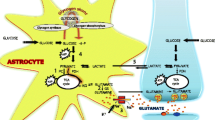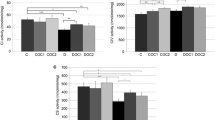Abstract
Diabetes affects a variety of tissues including the central nervous system; moreover, some evidence indicates that memory and learning processes are disrupted. Also, oxidative stress triggers alterations in different tissues including the brain. Recent studies indicate mitochondria dysfunction is a pivotal factor for neuron damage. Therefore, we studied mitochondrial activity in three brain regions at early type I—diabetes induction. Isolated mitochondria from normal hippocampus, cortex and cerebellum revealed different rates of oxygen consumption, but similar respiratory controls. Oxygen consumption in basal state 4 significantly increased in the mitochondria from all three brain regions from diabetic rats. No relevant differences were observed in the activity of respiratory complexes, but hippocampal mitochondrial membrane potential was reduced. However, ATP content, mitochondrial cytochrome c, and protein levels of β-tubulin III, synaptophysin, and glutamine synthase were similar in brain regions from normal and diabetic rats. In addition, no differences in total glutathione levels were observed between normal and diabetic rat brain regions. Our results indicated that different regions of the brain have specific metabolic responses. The changes in mitochondrial activity we observed at early diabetes induction did not appear to cause metabolic alterations, but they might appear at later stages. Longer-term streptozotocin treatment studies must be done to elucidate the impact of hyperglycemia in brain metabolism and the function of specific brain regions.







Similar content being viewed by others
References
Ryan CM (1988) Neurobehavioral complications of type I diabetes: examination of possible risk factors. Diabetes Care 11(1):86–93
Ryan CM, Williams TM, Finegold DN, Orchard TJ (1993) Cognitive dysfunction in adults with type 1 (insulin-dependent) diabetes mellitus of long duration: effects of recurrent hypoglycaemia and other chronic complications. Diabetologia 36(4):329–334
Ott A, Stolk RP, van Harskamp F, Pols HA, Hofman A, Breteler MM (1999) Diabetes mellitus and the risk of dementia: the Rotterdam Study. Neurology 53(9):1937–1942
Brands AM, Kessels RP, de Haan EH, Kappelle LJ, Biessels GJ (2004) Cerebral dysfunction in type 1 diabetes: effects of insulin, vascular risk factors and blood-glucose levels. Eur J Pharmacol 490(1–3):159–168
Strachan MW, Deary IJ, Ewing FM, Frier BM (1997) Is type II diabetes associated with an increased risk of cognitive dysfunction? A critical review of published studies. Diabetes Care 20(3):438–445
Allen KV, Frier BM, Strachan MW (2004) The relationship between type 2 diabetes and cognitive dysfunction: longitudinal studies and their methodological limitations. Eur J Pharmacol 490(1–3):169–175
Kivipelto M, Helkala EL, Laakso MP, Hänninen T, Hallikainen M, Alhainen K, Soininen H, Tuomilehto J, Nissinen A (2001) Midlife vascular risk factors and Alzheimer’s disease in later life: longitudinal, population based study. BMJ 322(7300):1447–1451
Whitmer RA, Sidney S, Selby J, Johnston SC, Yaffe K (2005) Midlife cardiovascular risk factors and risk of dementia in late life. Neurology 64(2):277–281
Sonnen JA, Larson EB, Brickell K, Crane PK, Woltjer R, Montine TJ, Craft S (2009) Different patterns of cerebral injury in dementia with or without diabetes. Arch Neurol 66(3):315–322. https://doi.org/10.1001/archneurol.2008.579
Peila R, Rodriguez BL, Launer LJ, Study H-AA (2002) Type 2 diabetes, APOE gene, and the risk for dementia and related pathologies: the Honolulu-Asia Aging Study. Diabetes 51(4):1256–1262
Ahtiluoto S, Polvikoski T, Peltonen M, Solomon A, Tuomilehto J, Winblad B, Sulkava R, Kivipelto M (2010) Diabetes, Alzheimer disease, and vascular dementia: a population-based neuropathologic study. Neurology 75(13):1195–1202. https://doi.org/10.1212/WNL.0b013e3181f4d7f8
Wang WT, Lee P, Yeh HW, Smirnova IV, Choi IY (2012) Effects of acute and chronic hyperglycemia on the neurochemical profiles in the rat brain with streptozotocin-induced diabetes detected using in vivo (1)H MR spectroscopy at 9.4 T. J Neurochem 121(3):407–417. https://doi.org/10.1111/j.1471-4159.2012.07698.x
de la Monte SM (2014) Type 3 diabetes is sporadic Alzheimers disease: mini-review. Eur Neuropsychopharmacol 24(12):1954–1960. https://doi.org/10.1016/j.euroneuro.2014.06.008
Mastrocola R, Restivo F, Vercellinatto I, Danni O, Brignardello E, Aragno M, Boccuzzi G (2005) Oxidative and nitrosative stress in brain mitochondria of diabetic rats. J Endocrinol 187(1):37–44
Sas K, Robotka H, Toldi J, Vécsei L (2007) Mitochondria, metabolic disturbances, oxidative stress and the kynurenine system, with focus on neurodegenerative disorders. J Neurol Sci 257(1–2):221–239
Poprac P, Jomova K, Simunkova M, Kollar V, Rhodes CJ, Valko M (2017) Targeting free radicals in oxidative stress-related human diseases. Trends Pharmacol Sci 38(7):592–607. https://doi.org/10.1016/j.tips.2017.04.005
Raha S, Robinson BH (2000) Mitochondria, oxygen free radicals, disease and ageing. Trends Biochem Sci 25(10):502–508
Duchen MR (2004) Roles of mitochondria in health and disease. Diabetes 53(Suppl 1):S96–S102
Sokoloff L (1999) Energetics of functional activation in neural tissues. Neurochem Res 24(2):321–329
Cardoso S, Correia SC, Santos RX, Carvalho C, Candeias E, Duarte AI, Placido AI, Santos MS, Moreira PI (2013) Hyperglycemia, hypoglycemia and dementia: role of mitochondria and uncoupling proteins. Curr Mol Med 13(4):586–601
Salceda R, Vilchis C, Coffe V, Hernandez-Munoz R (1998) Changes in the redox state in the retina and brain during the onset of diabetes in rats. Neurochem Res 23(6):893–897
Sánchez-Chávez GH-RE, Osorio-Paz I, Hernández-Espinosa C, Salceda R (2016) Potential role of endoplasmic reticulum stress in pathogenesis of diabetic retinopathy. Neurochem Res 41(5):1098–1106. https://doi.org/10.1007/s11064-015-1798-4
Rahman I, Kode A, Biswas SK (2006) Assay for quantitative determination of glutathione and glutathione disulfide levels using enzymatic recycling method. Nat Protoc 1(6):3159–3165
Trautschold IL, Schweitzer G (1988) Adenosine 5′triphosphate. UV-Method with hexokinase and glucose-6-phosphate dehydrogenase. In: Bergmeyer HU (ed) Bergmeyer enzymatic methods VII: 346–357, vol VII, 3rd edn. Verlag Chemie, Weinheim
Osorio-Paz I, Uribe-Carvajal S, Salceda R (2015) In the early stages of diabetes, rat retinal mitochondria undergo mild uncoupling due to UCP2 activity. PLoS ONE 10(5):e0122727. https://doi.org/10.1371/journal.pone.0122727
Birch-Machin MA, Turnbull DM (2001) Assaying mitochondrial respiratory complex activity in mitochondria isolated from human cells and tissues. Methods Cell Biol 65:97–117
Akerman KE, Wikström MK (1976) Safranine as a probe of the mitochondrial membrane potential. FEBS Lett 68(2):191–197
Kulikov AV, Shilov ES, Mufazalov IA, Gogvadze V, Nedospasov SA, Zhivotovsky B (2012) Cytochrome c: the Achilles’ heel in apoptosis. Cell Mol Life Sci 69(11):1787–1797. https://doi.org/10.1007/s00018-011-0895-z
Amaral S, Oliveira PJ, Ramalho-Santos J (2008) Diabetes and the impairment of reproductive function: possible role of mitochondria and reactive oxygen species. Curr Diabetes Rev 4(1):46–54
Turan B (2010) Role of antioxidants in redox regulation of diabetic cardiovascular complications. Curr Pharm Biotechnol 11(8):819–836
Gold SM, Dziobek I, Sweat V, Tirsi A, Rogers K, Bruehl H, Tsui W, Richardson S, Javier E, Convit A (2007) Hippocampal damage and memory impairments as possible early brain complications of type 2 diabetes. Diabetologia 50(4):711–719
Alvarez EO, Beauquis J, Revsin Y, Banzan AM, Roig P, De Nicola AF, Saravia F (2009) Cognitive dysfunction and hippocampal changes in experimental type 1 diabetes. Behav Brain Res 198(1):224–230. https://doi.org/10.1016/j.bbr.2008.11.001
Sasaki-Hamada S, Sacai H, Oka JI (2012) Diabetes onset influences hippocampal synaptic plasticity in streptozotocin-treated rats. Neuroscience 27:293–304. https://doi.org/10.1016/j.neuroscience.2012.09.081
Knierim JJ, Hamilton DA (2011) Framing spatial cognition: neural representations of proximal and distal frames of reference and their roles in navigation. Physiol Rev 91(4):1245–1279. https://doi.org/10.1152/physrev.00021.2010
Schneider M, Retz W, Coogan A, Thome J, Rösler M (2006) Anatomical and functional brain imaging in adult attention-deficit/hyperactivity disorder (ADHD)—a neurological view. Eur Arch Psychiatry Clin Neurosci 256(Suppl 1):i32–i41
Eccles JC (1981) Physiology of motor control in man. Appl Neurophysiol 44(1–3):5–15
Allen G, Buxton RB, Wong EC, Courchesne E (1997) Attentional activation of the cerebellum independent of motor involvement. Science 275(5308):1940–1943
Schmahmann JD, Caplan D (2006) Cognition, emotion and the cerebellum. Brain 129(Pt 2):290–292
Grillo C, Piroli G, Wood G, Reznikov LR, McEwen B, Reagan LP (2005) Immunocytochemical analysis of synaptic proteins provides new insights into diabetes-mediated plasticity in the rat hippocampus. Neuroscience 136(2):477–486
Moreira PI, Santos MS, Moreno AM, Proença T, Seiça R, Oliveira CR (2004) Effect of streptozotocin-induced diabetes on rat brain mitochondria. J Neuroendocrinol 16(1):32–38
Artola A, Kamal A, Ramakers GM, Biessels GJ, Gispen WH (2005) Diabetes mellitus concomitantly facilitates the induction of long-term depression and inhibits that of long-term potentiation in hippocampus. Eur J Neurosci 22(1):169–178
Cardoso S, Santos RX, Correia SC, Carvalho C, Santos MS, Baldeiras I, Oliveira CR, Moreira P (2013) Insulin-induced recurrent hypoglycemia exacerbates diabetic brain mitochondrial dysfunction and oxidative imbalance. Neurobiol Dis 49:1–12. https://doi.org/10.1016/j.nbd.2012.08.008
Sanchez-Chavez G, Salceda R (2000) Effect of streptozotocin-induced diabetes on activities of cholinesterases in the rat retina. IUBMB Life 49(4):283–287. https://doi.org/10.1080/15216540050033140
Acknowledgements
The authors would like to thank Mr. G. Sánchez-Chávez for technical assistance, Mr. Diego Barjau for helping in some experiments. We also acknowledge to the Animal, Computational, and Supporting Facilities Units. This research was supported in part by a grant from Dirección General de Asuntos del Personal Académico/Programa de Apoyo de Investigación e Innovación Tecnológica/UNAM/DGAPA/PAPIIT-IG200216. Osorio-Paz received a doctoral scholarship from CONACyT México (263808/221053) enrolled in the Biochemistry PhD program at UNAM.
Author information
Authors and Affiliations
Contributions
IO-P participated in the design of the experiments, writing the manuscript and carried out the experiments of mitochondrial activity. GP-R developed the western blot experiments, and participated in the discussion. JEH-R measured the GSH levels and ROS production. SUC help in the studies of mitochondrial activity, discussion and writing the manuscript. RS designed, coordinated the research and wrote the paper, funding acquisition.
Corresponding author
Ethics declarations
Conflict of interest
The authors declare that they have no conflict of interest.
Research involving animal and human participants
All procedures were carried out in agreement with the Mexican Institute of Health Research (DOF. NOM-062-ZOO-1999) and the National Institutes of Health Guide for the Care and Use of Laboratory Animals (NIH publication No. 80-23, revised 1996). The protocol was approved by the Institutional Committee for the Care and Use of Laboratory Animals of the Institute of Cellular Physiology of the Autonomous National University of Mexico (CICUAL Comité Institucional para el Cuidado y Uso de los Animales de Laboratorio del Instituto de Fisiología Celular de la Universidad Nacional Autónoma de México) under Protocol Number RSS18-14; this was done in accordance with the Office of Laboratory Animal Welfare (OLAW), Assurance Number A5281-01. All efforts were made to minimize animal suffering and to reduce the number of rats used.
Rights and permissions
About this article
Cite this article
Osorio-Paz, I., Ramírez-Pérez, G., Hernández-Ramírez, J.E. et al. Mitochondrial activity in different regions of the brain at the onset of streptozotocin-induced diabetes in rats. Mol Biol Rep 45, 871–879 (2018). https://doi.org/10.1007/s11033-018-4233-5
Received:
Accepted:
Published:
Issue Date:
DOI: https://doi.org/10.1007/s11033-018-4233-5




